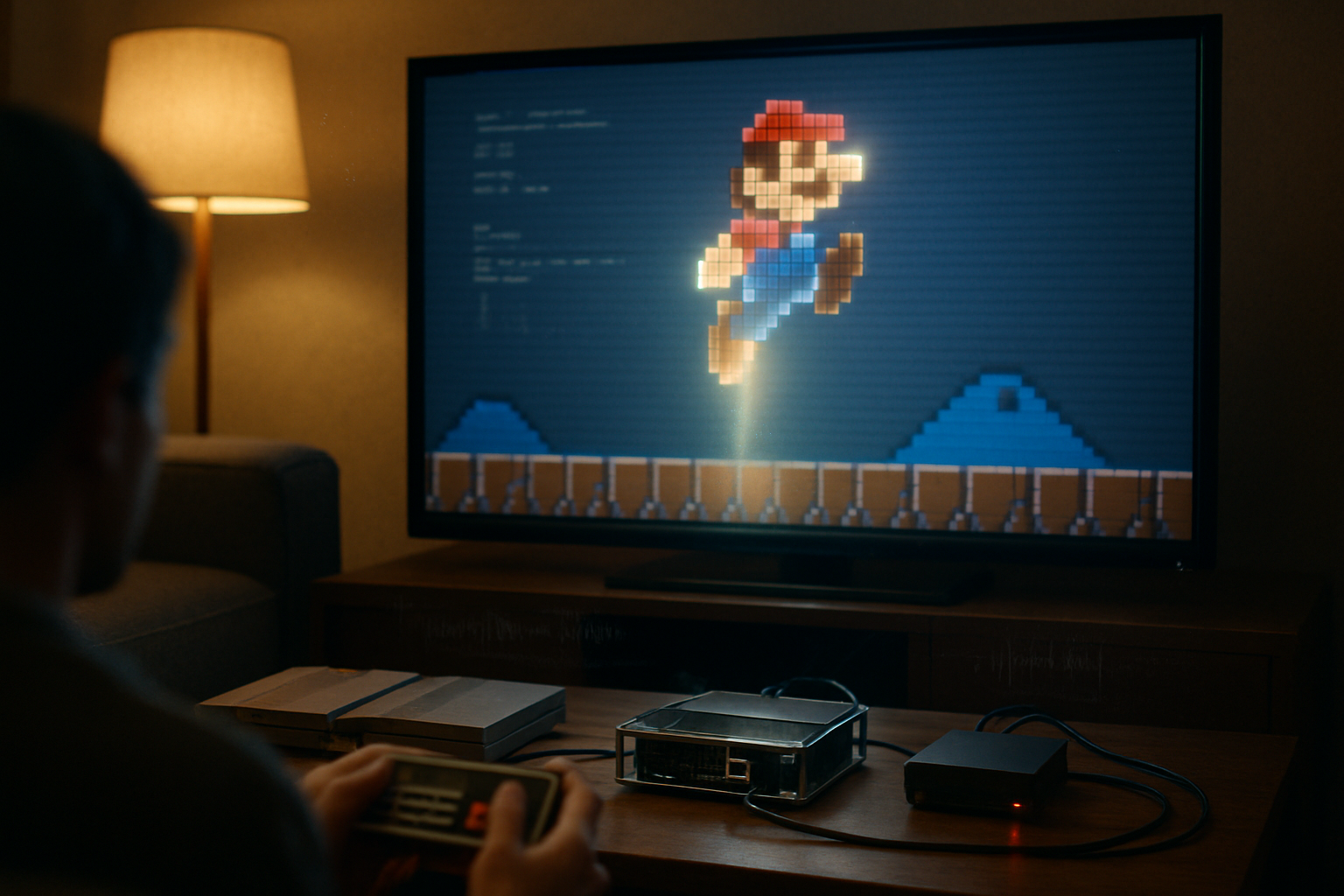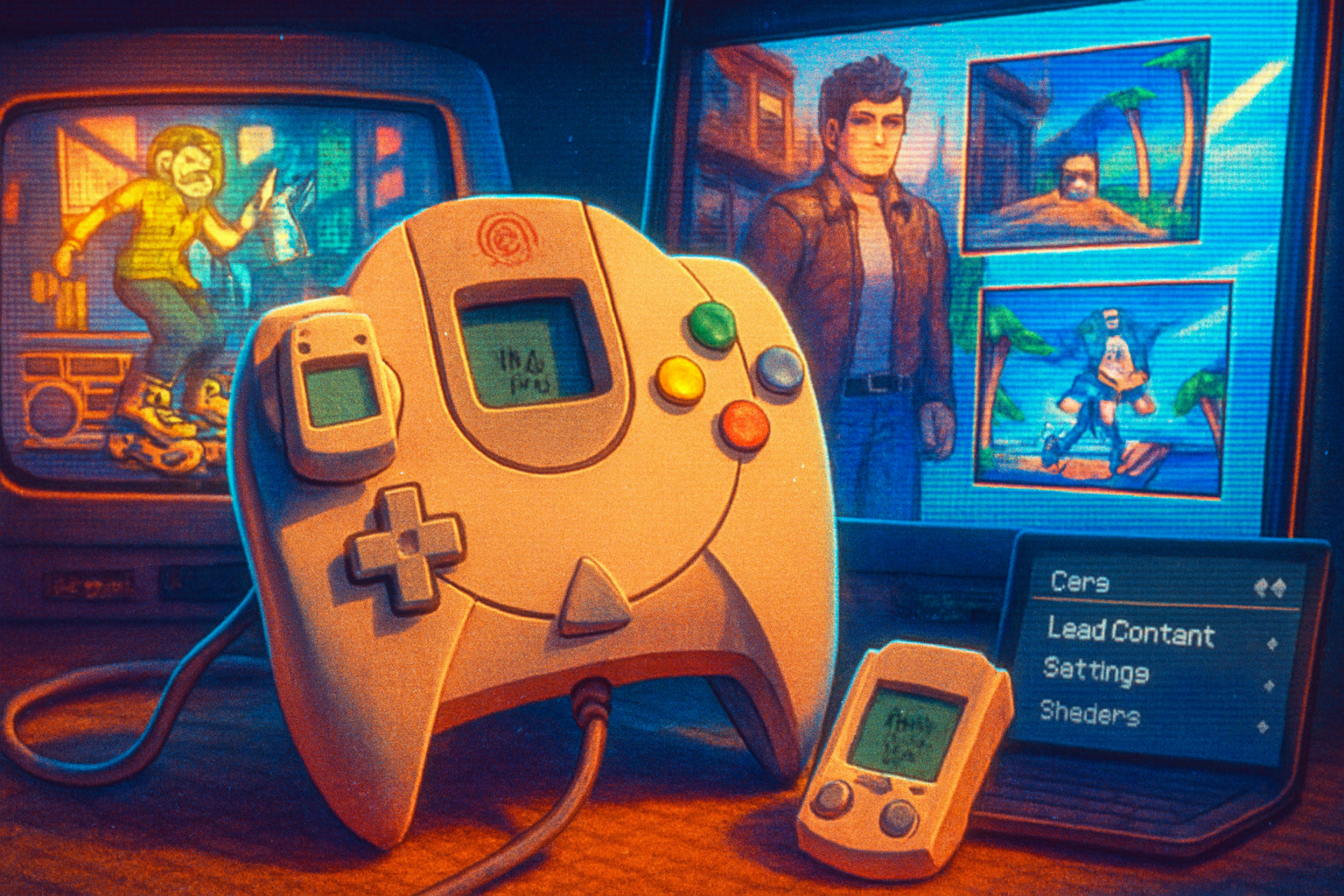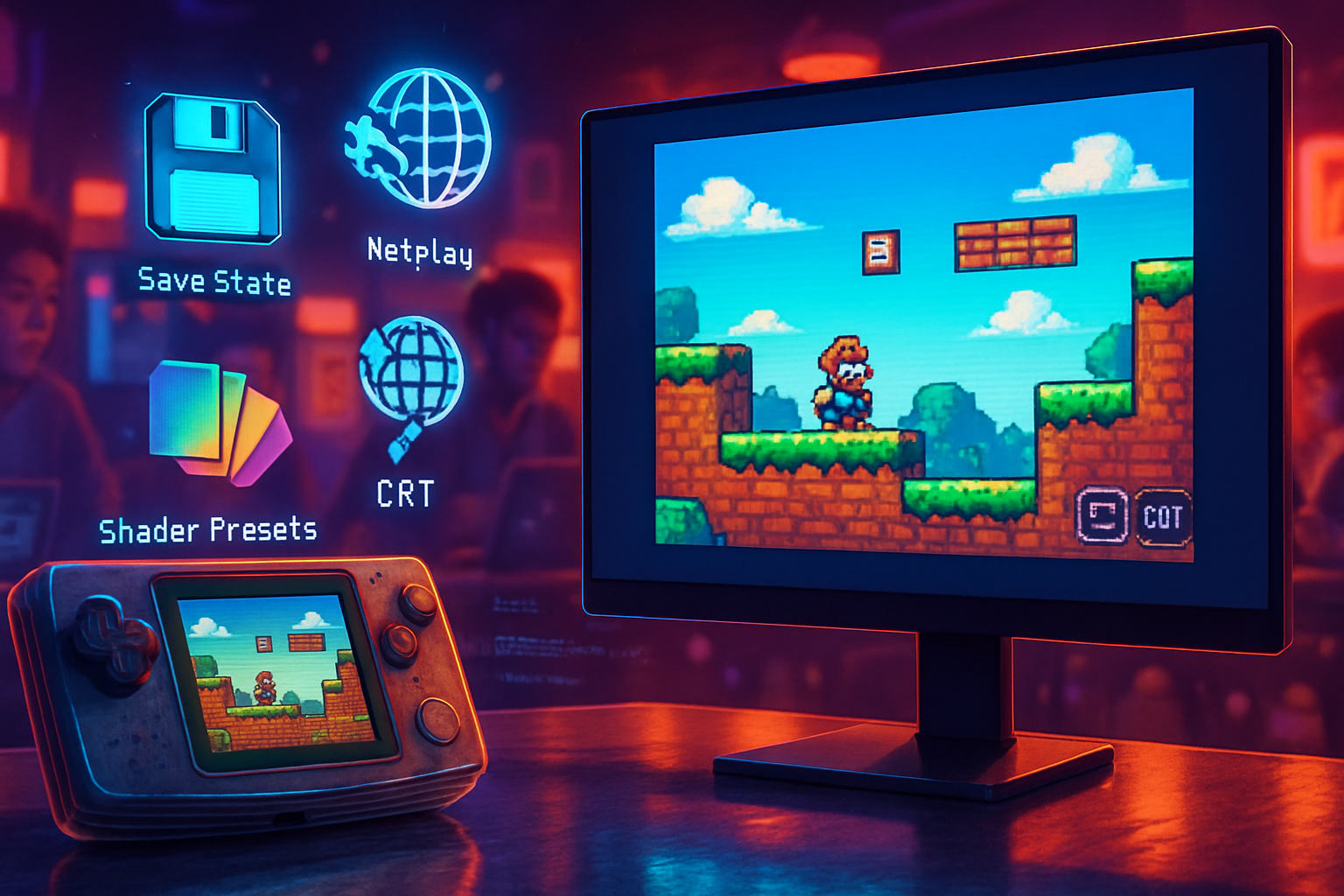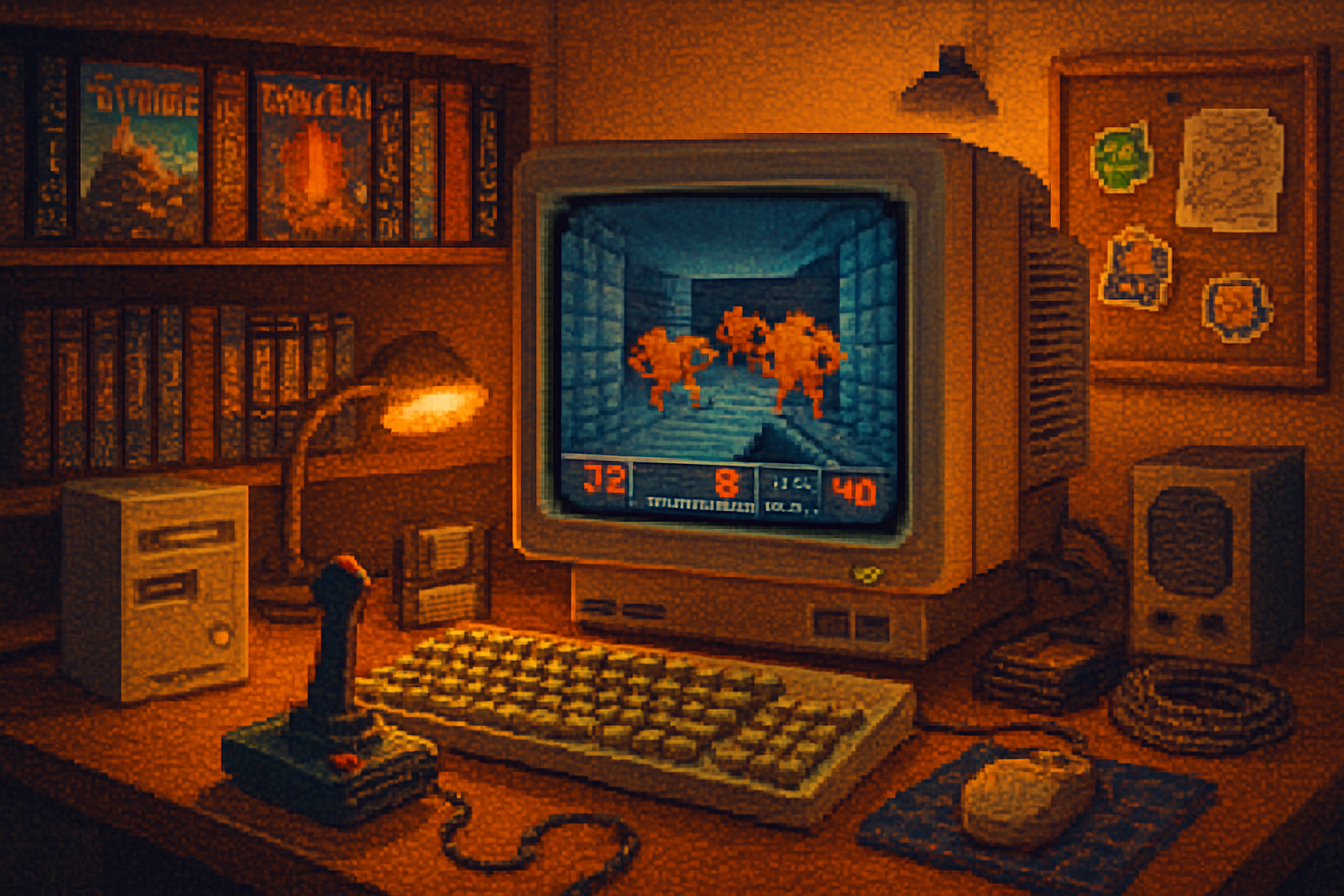· retrogaming · 6 min read
The Emulation Revolution: How NES Emulators Are Reshaping Retro Gaming
From browser play to FPGA accuracy: how NES emulation transformed preservation, accessibility, and nostalgia for classic games - and why the legal and ethical fight still matters.

A kid in 1986 stuck his tongue out at a stubborn jump and reset the cartridge. Today, a grown-up with less patience and better internet can rewind that very frame, fix the mistake, and upload the clip to a million-view video. That, in miniature, is the emulation revolution: a quiet engineering achievement that rewired how we play, preserve, and remember games - starting with the Nintendo Entertainment System (NES).
Why the NES matters
The NES is not just a dusty rectangle of plastic. It is the technical and cultural crucible that turned arcades into living-room epics. Titles like Super Mario Bros., The Legend of Zelda, and Metroid rewrote what games could be. They also left design choices and hardware quirks - mappers, audio chips, timing bugs - that later generations would mistake for flaws rather than features.
If music is like oxygen, nostalgia is like perfume: you notice it only when it’s absent. Emulation brought that scent back into the room.
What is an emulator, really?
At its simplest: an emulator is software that imitates the hardware and behavior of another system so software written for the original runs on modern machines. The cold explanation hides the artistry. Emulating an NES well requires reproducing hardware timing, CPU quirks, PPU (picture processing unit) oddities, and even the idiosyncratic behavior of third-party mappers - little memory-management chips that added functionality to cartridges.
Early emulators were crude and convenient. Modern ones are forensic. Developers today chase cycle-accuracy: matching how the original machine processed every clock tick so graphical glitches and sound bleed - the very things that made a game feel “right” - show up where they did in 1987.
Helpful links:
- RetroArch and Libretro - a modern, modular front-end and cores ecosystem for emulation and more [
- FCEUX - a long-running NES emulator used by researchers and speedrunners [
The technical arms race: accuracy, convenience, and fidelity
Emulation has moved through clear phases:
- Brutal convenience (play anything, anywhere). Early emulators prioritized breadth over faithfulness.
- Competitive correctness (speedrunning and TAS). Players demanded deterministic playback and frame-accurate inputs.
- Scholarly fidelity (preservationists). Coders like preservationists - they want the machine reconstructed down to its silicon ghosts.
That last phase brought several innovations:
- Cycle-accurate cores that reproduce CPU/PPU timing.
- Mapper support to run obscure and region-specific cartridges.
- Netplay, save states, and rewind features that change how games are experienced.
- Shader packs and filtering that let players choose an aesthetic between CRT warmth and pixel-perfect sharpness.
When players can choose how a game looks and behaves, we stop treating the original as an immutable monument and start treating it as a living text.
FPGA and hardware re-creation: when imitation becomes sculpture
Software emulation is one approach. Another is to recreate the original hardware logic using Field-Programmable Gate Arrays (FPGAs). Projects like MiSTer (https://misterfpga.org/) and boutique consoles like Analogue’s Nt series (https://www.analogue.co/) rebuild the behavior of the NES at the gate level.
Why FPGA matters:
- Latency reduction. FPGAs can match the original console’s responsiveness better than software running on general-purpose OSes.
- Long-term stability. Recreating the logic rather than simulating it helps sidestep OS and driver rot.
- Purist appeal. For some collectors and preservationists, FPGA-based replicas are the closest thing to time travel.
But FPGAs are expensive and specialist. Emulation remains the most democratic path.
Emulators and preservation: libraries, dats, and the archaeology of code
Games are fragile. Cartridges degrade. Manufacturing data is lost. Emulation has become a preservation discipline as much as a hobby.
Key players and practices:
- The Internet Archive (https://archive.org/) has hosted console game collections and browser-playable ROMs to preserve cultural artifacts, sparking fierce debates about copyright.
- No-Intro and similar groups maintain datfiles that catalog verified ROM dumps and metadata - a librarian’s taxonomy for digital artifacts [https://datomatic.no-intro.org/].
- Community-led ROM dumps and hardware tools catalog region variants, prototype builds, and translator patches - material historians drool over.
Preservationists argue that without accurate emulators and robust archives, much of early game heritage will be lost to dead media formats and corporate indifference. They’re not wrong.
Nostalgia, accessibility, and cultural rediscovery
Emulation did more than save files. It created new audiences. Teens who grew up after the NES era discover 8-bit design discipline and emergent aesthetics on Twitch and YouTube. Speedrunners and TASers mine hardware quirks to create performances that are simultaneously play and scholarship.
Other effects:
- Fan translations and hacks make otherwise region-locked stories accessible.
- Modding communities rework classics into new experiences, keeping them alive.
- Educational uses - game-development instructors use emulators to illustrate hardware constraints and clever design workarounds.
Nostalgia is not just sentiment. It’s a reframing device that lets new creators stand on the shoulders of old code.
The legal and ethical thickets
Here the air gets thin. Emulation itself is perfectly legal in most jurisdictions. Distributing copyrighted ROMs without permission is not. Nintendo has been a particularly aggressive plaintiff; cases and takedowns - and high-profile settlements like the LoveROMS/LoveRETRO episode covered by Ars Technica - make that clear [https://arstechnica.com/gaming/2018/09/nintendo-wins-2-1m-from-lovers-of-pirated-roms-judge-says/].
Useful framing:
- Emulation = neutral technology. A scalpel can heal or kill.
- ROM distribution without rights = theft of copyrighted property.
- Preservationists often operate in a gray zone, arguing cultural value and archival need, but the law rarely rewards good intentions.
The correct moral stance is clear: emulation is a preservation tool, not a legal loophole. If you care about these games surviving, advocate for legal deposit, museum partnerships, and corporate release of archival collections.
Where the industry stands: partnerships, re-releases, and hostility
Big companies have reacted unevenly. Nintendo has historically fought emulation and ROM sites while monetizing its back catalog through services like Nintendo Switch Online and curated re-releases. Other companies have embraced preservation more openly.
Possible future paths:
- Licensed archives. Publishers could partner with museums and archives to release verified dumps under controlled access.
- Commercial reissues. Collections and remasters will continue; they’re lucrative. But they often sanitize quirks that preservationists want to keep.
- Legal reform. Right now, laws favor active IP holders; better frameworks for cultural preservation would help bridge the gap.
Why it matters: more than pixels
The emulation revolution is not just nostalgia porn or cheap thrills for collectors. It’s an argument about cultural memory. Musicologists preserve recordings; archivists preserve books; we must preserve games - code and hardware behavior alike - because they capture design decisions, social contexts, and emotional labor.
If we fail at preservation, we don’t just lose entertainment. We lose a laboratory where future designers learn how constraints breed creativity.
Practical ethics for players and preservationists
- Favor legal sources when available - official re-releases, subscription services, museum projects.
- Support preservation efforts - Donate to or volunteer with archives and museums that preserve games.
- Avoid casual piracy. Hiding behind “for preservation” is not an ethical free pass unless you’re operating under an institutionally sanctioned archival exception.
The horizon: emulation as cultural infrastructure
Emulators will keep improving. Cores will grow more exacting. FPGA projects will refine the art of hardware resurrection. Meanwhile, communities will keep digging up prototypes, region hacks, and lost-media treasures.
We’re at the moment where emulation stops being a niche trick and becomes infrastructure: the plumbing that lets future generations study and enjoy the first decades of video-game history. That infrastructure deserves funding, legal clarity, and moral seriousness.
If you love these games, fight for them. Not with piracy, but with institutions, advocacy, and well-funded archives.
Further reading and sources
- RetroArch - Official site: https://www.retroarch.com/
- FCEUX - NES emulator: https://fceux.com/
- MiSTer FPGA project: https://misterfpga.org/
- Analogue (Nt & hardware recreations): https://www.analogue.co/
- No-Intro dats and cataloging: https://datomatic.no-intro.org/
- Internet Archive: https://archive.org/
- Ars Technica coverage of Nintendo legal action: https://arstechnica.com/gaming/2018/09/nintendo-wins-2-1m-from-lovers-of-pirated-roms-judge-says/
- Video game preservation overview: https://en.wikipedia.org/wiki/Video_game_preservation



